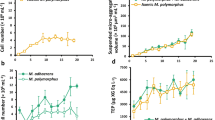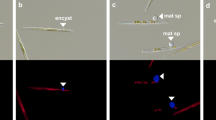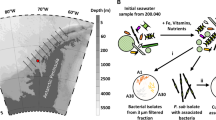Abstract
Aggregation of algae, mainly diatoms, is an important process in marine systems leading to the settling of particulate organic carbon predominantly in the form of marine snow. Exudation products of phytoplankton form transparent exopolymer particles (TEP), which acts as the glue for particle aggregation. Heterotrophic bacteria interacting with phytoplankton may influence TEP formation and phytoplankton aggregation. This bacterial impact has not been explored in detail. We hypothesized that bacteria attaching to Thalassiosira weissflogii might interact in a yet-to-be determined manner, which could impact TEP formation and aggregate abundance. The role of individual T. weissflogii-attaching and free-living new bacterial isolates for TEP production and diatom aggregation was investigated in vitro. T. weissflogii did not aggregate in axenic culture, and striking differences in aggregation dynamics and TEP abundance were observed when diatom cultures were inoculated with either diatom-attaching or free-living bacteria. The data indicated that free-living bacteria might not influence aggregation whereas bacteria attaching to diatom cells may increase aggregate formation. Interestingly, photosynthetically inactivated T. weissflogii cells did not aggregate regardless of the presence of bacteria. Comparison of aggregate formation, TEP production, aggregate sinking velocity and solid hydrated density revealed remarkable differences. Both, photosynthetically active T. weissflogii and specific diatom-attaching bacteria were required for aggregation. It was concluded that interactions between heterotrophic bacteria and diatoms increased aggregate formation and particle sinking and thus may enhance the efficiency of the biological pump.
Similar content being viewed by others
Log in or create a free account to read this content
Gain free access to this article, as well as selected content from this journal and more on nature.com
or
References
Alderkamp AC, van Rijssel M, Bolhuis H . (2007). Characterization of marine bacteria and the activity of their enzyme systems involved in degradation of the algal storage glucan laminarin. Fems Microbiology Ecology 59: 108–117.
Alldredge AL, Gotschalk CC . (1989). Direct observations of the mass flocculation of diatom blooms: characteristics, settling velocities and formation of diatom aggregates. Deep Sea Research Part A. Oceanographic Research Papers 36: 159–171.
Alldredge AL, Passow U, Logan BE . (1993). The abundance and significance of a class of large, transparent organic particles in the ocean. Deep-Sea Research Part I-Oceanographic Research Papers 40: 1131–1140.
Azam F, Malfatti F . (2007). Microbial structuring of marine ecosystems. Nature Reviews Microbiology 5: 782–791 (Review. Erratum in: Nat Rev Microbiol. 2007 5(12):966).
Azam F, Smith DC, Steward GF, Hagstrom A . (1994). Bacteria—organic-matter coupling and its significance for oceanic carbon cycling. Microbial Ecology 28: 167–179.
Azetsu-Scott K, Passow U . (2004). Ascending marine particles: significance of transparent exopolymer particles (TEP) in the upper ocean. Limnology and Oceanography 49: 741–748.
Beauvais S, Pedrotti ML, Egge J, Iversen K, Marrase C . (2006). Effects of turbulence on TEP dynamics under contrasting nutrient conditions: implications for aggregation and sedimentation processes. Marine Ecology-Progress Series 323: 47–57.
Bell W, Mitchell R . (1972). Chemotactic and growth responses of marine bacteria to algal extracellular products. Biological Bulletin 143: 265.
Bhaskar PV, Grossart HP, Bhosle NB, Simon M . (2005). Production of macroaggregates from dissolved exopolymeric substances (EPS) of bacterial and diatom origin. Fems Microbiology Ecology 53: 255–264.
Blackburn N, Fenchel T, Mitchell J . (1998). Microscale nutrient patches in planktonic habitats shown by chemotactic bacteria. Science 282: 2254–2256.
Cole JJ . (1982). Interactions between bacteria and algae in aquatic ecosystems. Annual Review of Ecology and Systematics 13: 291–314.
Crocker KM, Passow U . (1995). Differential aggregation of diatoms. Marine Ecology-Progress Series 117: 249–257.
Decho AW . (1990). Microbial exopolymer secretions in ocean environments—their role(s) in food webs and marine processes. Oceanography and Marine Biology 28: 73–153.
Engel A . (2000). The role of transparent exopolymer particles (TEP) in the increase in apparent particle stickiness (alpha) during the decline of a diatom bloom. Journal of Plankton Research 22: 485–497.
Feinberg LR, Dam HG . (1998). Effects of diet on dimensions, density and sinking rates of fecal pellets of the copepod Acartia tonsa. Marine Ecology Progress Series 175: 87–96.
Fowler SW, Knauer GA . (1986). Role of large particles in the transport of elements and organic compounds through the oceanic water column. Progress in Oceanography 16: 147–194.
Genty B, Briantais JM, Baker NR . (1989). The relationship between the quantum yield of photosynthetic electron-transport and quenching of chlorophyll fluorescence. Biochimica Et Biophysica Acta 990: 87–92.
Grossart HP . (1999). Interactions between marine bacteria and axenic diatoms (Cylindrotheca fusiformis, Nitzschia laevis, and Thalassiosira weissflogii) incubated under various conditions in the lab. Aquatic Microbial Ecology 19: 1–11.
Grossart HP, Czub G, Simon M . (2006a). Algae-bacteria interactions and their effects on aggregation and organic matter flux in the sea. Environmental Microbiology 8: 1074–1084.
Grossart HP, Kiorboe T, Tang KW, Allgaier M, Yam EM, Ploug H . (2006b). Interactions between marine snow and heterotrophic bacteria: aggregate formation and microbial dynamics. Aquatic Microbial Ecology 42: 19–26.
Grossart HP, Levold F, Allgaier M, Simon M, Brinkhoff T . (2005). Marine diatom species harbour distinct bacterial communities. Environmental Microbiology 7: 860–873.
Grossart HP, Schlingloff A, Bernhard M, Simon M, Brinkhoff T . (2004). Antagonistic activity of bacteria isolated from organic aggregates of the german wadden sea. Fems Microbiology Ecology 47: 387–396.
Grossart HP, Simon M . (2007). Interactions of planktonic algae and bacteria: effects on algal growth and organic matter dynamics. Aquatic Microbial Ecology 47: 163–176.
Guillard RRL . (1975). Culture of phytoplankton for feeding marine invertebrates. In: Smith WL, Chanley MH (eds). Culture of Marine Invertebrate Animals. Plenum Press: New York, USA, pp 108–132.
Jackson GA . (1990). A model of the formation of marine algal flocs by physical coagulation processes. Deep Sea Research Part A. Oceanographic Research Papers 37: 1197–1211.
Jackson GA . (1995). TEP and coagulation during a mesocosm experiment. Deep Sea Research Part II: Topical Studies in Oceanography 42: 215–222.
Jackson GA . (2001). Effect of coagulation on a model planktonic food web. Deep Sea Research Part I: Oceanographic Research Papers 48: 95–123.
Jackson GA . (2005). Coagulation theory and models of oceanic plankton aggregation. In: Droppo I, Leppard G, Liss S, Milligan T (eds). Flocculation in Natural and Engineered Environmental Systems. CRC Press. pp 271–292.
Judy D, Clarice MY, Sara M, Colleen M . (1989). Rapid analytical technique for the assessment of cell metabolic activity in marine microalgae. Cytometry 10: 622–628.
Kahl LA, Vardi A, Schofield O . (2008). Effects of phytoplankton physiology on export flux. Marine Ecology-Progress Series 354: 3–19.
Kiørboe T, Andersen KP, Dam HG . (1990). Coagulation efficiency and aggregate formation in marine phytoplankton. Marine Biology 107: 235–245.
Kiørboe T, Hansen JLS . (1993). Phytoplankton aggregate formation: observations of patterns and mechanisms of cell sticking and the significance of exopolymeric material. J Plankton Res 15: 993–1018.
Kiørboe T, Lundsgaard C, Olesen M, Hansen JLS . (1994). Aggregation and sedimentation processes during a spring phytoplankton bloom—a field experiment to test coagulation theory. Journal of Marine Research 52: 297–323.
Kogure K, Simidu U, Taga N . (1981). Bacterial attachment to phytoplankton in sea-water. Journal of Experimental Marine Biology and Ecology 56: 197–204.
Kolber Z, Falkowski PG . (1993). Use of active fluorescence to estimate phytoplankton photosynthesis in-situ. Limnology and Oceanography 38: 1646–1665.
Lewis J, Kennaway G, Franca S, Alverca E . (2001). Bacterium-dinoflagellate interactions: investigative microscopy of Alexandrium spp. (Gonyaulacales, Dinophyceae). Phycologia 40: 280–285.
Logan BE, Grossart HP, Simon M . (1994). Direct observation of phytoplankton, Tep and aggregates on polycarbonate filters using brightfield microscopy. Journal of Plankton Research 16: 1811–1815.
Logan BE, Passow U, Alldredge AL, Grossart HP, Simon M . (1995). Rapid formation and sedimentation of large aggregates is predictable from coagulation rates (half-lives) of transparent exopolymer particles (Tep). Deep-Sea Research Part Ii-Topical Studies in Oceanography 42: 203–214.
Martin-Cereceda M, Williams R, Guinea A, Novarino G . (2007). An investigation of the fine structure, cell surface carbohydrates, and appeal of the diatom Extubocellulus sp as prey for small flagellates. Protoplasma 232: 69–78.
Muyzer G, Ramsing NB . (1995). Molecular methods to study the organization of microbial communities. Water Science and Technology 32: 1–9.
Myklestad SM . (1995). Release of extracellular products by phytoplankton with special emphasis on polysaccharides. Science of the Total Environment 165: 155–164.
Passow U . (2002a). Production of transparent exopolymer particles (TEP) by phyto- and bacterioplankton. Marine Ecology-Progress Series 236: 1–12.
Passow U . (2002b). Transparent exopolymer particles (TEP) in aquatic environments. Progress in Oceanography 55: 287–333.
Passow U, Alldredge AL . (1995a). Aggregation of a diatom bloom in a mesocosm—the role of transparent exopolymer particles (Tep). Deep-Sea Research Part Ii-Topical Studies in Oceanography 42: 99–109.
Passow U, Alldredge AL . (1995b). A dye-binding assay for the spectrophotometric measurement of transparent exopolymer particles (TEP). Limnology and Oceanography 40: 1326–1335.
Ploug H, Iversen MH, Fischer G . (2008). Ballast, sinking velocity, and apparent diffusivity within marine snow and zooplankton fecal pellets: implications for substrate turnover by attached bacteria. Limnology and Oceanography 53: 1878–1886.
Ploug H, Jørgensen BB . (1999). A net-jet flow system for mass transfer and microsensor studies of sinking aggregates. Marine Ecology Progress Series 176: 279–290.
Ploug H, Passow U . (2007). Direct measurement of diffusivity within diatom aggregates containing transparent exopolymer particles (TEP). Limnol Oceanogr 52: 1–6.
Porter KG, Feig YS . (1980). The use of DAPI for identifying and counting aquatic microflora. Limnology and Oceanography 25: 943–948.
Schreiber U . (1986). Detection of rapid induction kinetics with a new type of high-frequency modulated chlorophyll fluorometer. Photosynthesis Research 9: 261–272.
Schwinghamer P . (1991). Seperation and concentration of living dinoflagellate resting cysts from marine sediments via density-gradient centrifugation. Limnol Oceanogr 36: 588–592.
Shanks AL, Edmondson EW . (1989). Laboratory-made artificial marine snow: a biological model of the real thing. Mar Biol 101: 463–470.
Smetacek VS . (1985). Role of sinking in diatom life history cycles- ecological, evolutionary and geological significance. Marine Biology 84: 239–251.
Smith DC, Steward GF, Long RA, Azam F . (1995). Bacterial mediation of carbon fluxes during a diatom bloom in a mesocosm. Deep-Sea Research Part Ii-Topical Studies in Oceanography 42: 75–97.
Staats N, Stal LJ, Mur LR . (2000). Exopolysaccharide production by the epipelic diatom Cylindrotheca closterium: effects of nutrient conditions. Journal of Experimental Marine Biology and Ecology 249: 13–27.
Stoderegger KE, Herndl GJ . (1999). Production of exopolymer particles by marine bacterioplankton under contrasting turbulence conditions. Marine Ecology-Progress Series 189: 9–16.
Tien CJ, Sigee DC, White KN . (2005). Characterization of surface sugars on algal cells with fluorescein isothiocyanate-conjugated lectins. Protoplasma 225: 225–233.
Vaulot D, Olson RJ, Chisholm SW . (1986). Light and dark control of the cell cycle in 2 marine phytoplankton species. Experimental Cell Research 167: 38–52.
Waite AM, Olson RJ, Dan HG, Passow U . (1995). Sugar-containing compounds on the cell surfaces of marine diatoms measured using concanavalin A and flow cytometry. Journal of Phycology 31: 925–933.
Weast RC . (1968). Handbook Chemistry and Physics. 49th edn, CRC for Soil and Land Management: Boca Raton, FL, USA.
Wichels A, Wurtz S, Dopke H, Schutt C, Gerdts G . (2006). Bacterial diversity in the breadcrumb sponge Halichondria panicea (Pallas). Fems Microbiology Ecology 56: 102–118.
ZoBell CE . (1941). Studies on marine bacteria. I. The cultural requirements of heterotrophic aerobes. J Mar Res 4: 42–75.
Acknowledgements
We would like to thank Antje Wichels for support and providing bacterial isolates, Sven Kranz for assistance in determining the photosynthetic activity using PAM, Veit Wagner, Arne Hoppe and Yannic Ramaye support when using the scanning electron microscope. This work was financially supported by Jacobs University Bremen and Deutsche Forschungsgemeinschaft (GR1540-12/1).
Author information
Authors and Affiliations
Corresponding author
Additional information
Supplementary Information accompanies the paper on The ISME Journal website
Supplementary information
Rights and permissions
About this article
Cite this article
Gärdes, A., Iversen, M., Grossart, HP. et al. Diatom-associated bacteria are required for aggregation of Thalassiosira weissflogii. ISME J 5, 436–445 (2011). https://doi.org/10.1038/ismej.2010.145
Received:
Revised:
Accepted:
Published:
Issue date:
DOI: https://doi.org/10.1038/ismej.2010.145
Keywords
This article is cited by
-
Fungal parasitism on diatoms alters formation and bio–physical properties of sinking aggregates
Communications Biology (2023)
-
Chemotaxis increases metabolic exchanges between marine picophytoplankton and heterotrophic bacteria
Nature Microbiology (2023)
-
Impact of disposable mask microplastics pollution on the aquatic environment and microalgae growth
Environmental Science and Pollution Research (2023)
-
Particle-associated bacteria differentially influence the aggregation of the marine diatom Minutocellus polymorphus
ISME Communications (2022)
-
Evidence of the Significant Contribution of Heterotrophic Diazotrophs to Nitrogen Fixation in the Eastern Indian Ocean During Pre-Southwest Monsoon Period
Ecosystems (2022)



